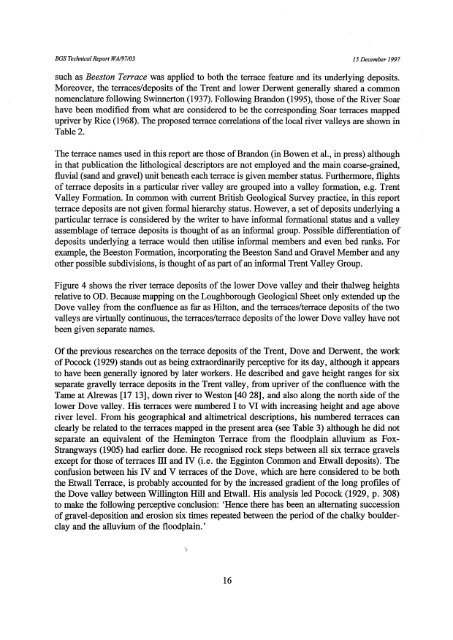Download (3723Kb) - NERC Open Research Archive - Natural ...
Download (3723Kb) - NERC Open Research Archive - Natural ...
Download (3723Kb) - NERC Open Research Archive - Natural ...
You also want an ePaper? Increase the reach of your titles
YUMPU automatically turns print PDFs into web optimized ePapers that Google loves.
BGS Technical Report WA/97/03 15 December 1997<br />
such as Beeston Terrace was applied to both the terrace feature and its underlying deposits.<br />
Moreover, the terracesldeposits of the Trent and lower Derwent generally shared a common<br />
nomenclature following Swinnerton (1937). Following Brandon (1995), those of the River Soar<br />
have been modified from what are considered to be the corresponding Soar terraces mapped<br />
upriver by Rice (1968). The proposed terrace correlations of the local river valleys are shown in<br />
Table 2.<br />
The terrace names used in this report are those of Brandon (in Bowen et al., in press) although<br />
in that publication the lithological descriptors are not employed and the main coarse-grained,<br />
fluvial (sand and gravel) unit beneath each terrace is given member status. Furthermore, flights<br />
of terrace deposits in a particular river valley are grouped into a valley formation, e.g. Trent<br />
Valley Formation. In common with current British Geological Survey practice, in this report<br />
terrace deposits are not given formal hierarchy status. However, a set of deposits underlying a<br />
particular terrace is considered by the writer to have informal formational status and a valley<br />
assemblage of terrace deposits is thought of as an informal group. Possible differentiation of<br />
deposits underlying a terrace would then utilise informal members and even bed ranks. For<br />
example, the Beeston Formation, incorporating the Beeston Sand and Gravel Member and any<br />
other possible subdivisions, is thought of as part of an informal Trent Valley Group.<br />
Figure 4 shows the river terrace deposits of the lower Dove valley and their thalweg heights<br />
relative to OD. Because mapping on the Loughborough Geological Sheet only extended up the<br />
Dove valley from the confluence as far as Hilton, and the terraceslterrace deposits of the two<br />
valleys are virtually continuous, the terraceslterrace deposits of the lower Dove valley have not<br />
been given separate names.<br />
Of the previous researches on the terrace deposits of the Trent, Dove and Derwent, the work<br />
of Pocock (1929) stands out as being extraordinarily perceptive for its day, although it appears<br />
to have been generally ignored by later workers. He described and gave height ranges for six<br />
separate gravelly terrace deposits in the Trent valley, from upriver of the confluence with the<br />
Tarne at Alrewas [17 131, down river to Weston [40 281, and also along the north side of the<br />
lower Dove valley. His terraces were numbered I to VI with increasing height and age above<br />
river level. From his geographical and altimetrical descriptions, his numbered terraces can<br />
clearly be related to the terraces mapped in the present area (see Table 3) although he did not<br />
separate an equivalent of the Hemington Terrace from the floodplain alluvium as Fox-<br />
Strangways (1905) had earlier done. He recognised rock steps between all six terrace gravels<br />
except for those of terraces 111 and IV (i.e. the Egginton Common and Etwall deposits). The<br />
confusion between his IV and V terraces of the Dove, which are here considered to be both<br />
the Etwall Terrace, is probably accounted for by the increased gradient of the long profiles of<br />
the Dove valley between Willington Hill and Etwall. His analysis led Pocock (1929, p. 308)<br />
to make the following perceptive conclusion: ‘Hence there has been an alternating succession<br />
of graveldeposition and erosion six times repeated between the period of the chalky boulderclay<br />
and the alluvium of the floodplain. ’<br />
16
















